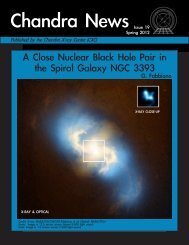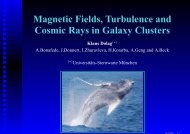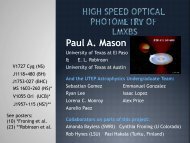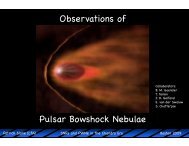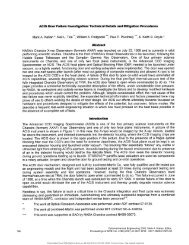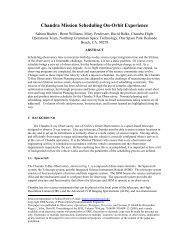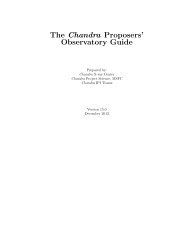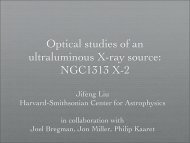observational overview of state transitions in x-ray binaries
observational overview of state transitions in x-ray binaries
observational overview of state transitions in x-ray binaries
You also want an ePaper? Increase the reach of your titles
YUMPU automatically turns print PDFs into web optimized ePapers that Google loves.
HYSTERESIS<br />
• Disc magnetization (Petrucci et al. 2008)<br />
• Compton cool<strong>in</strong>g/heat<strong>in</strong>g (Liu et al. 2005)<br />
• Two flow model - Keplerian/sub-Keplarian (Chakrabarti and<br />
Titarchuk 1995, Smith et al. 2002)<br />
radial <strong>in</strong>flow<br />
standard accretion disk<br />
black<br />
hole<br />
•Accretion disk ‘feeds’ faster radial <strong>in</strong>flow<br />
•Could expla<strong>in</strong> some <strong>of</strong> the behavior<br />
Some explanations have been proposed for the observed hysteresis. Pertucci et al. try to<br />
expla<strong>in</strong> the hysteresis <strong>in</strong> terms <strong>of</strong> a large scale magnetic field that results <strong>in</strong> different<br />
lum<strong>in</strong>osities for <strong>transitions</strong> between standard disk and jet produc<strong>in</strong>g disc. Liu et al. suggest<br />
that differences <strong>in</strong> Compton heat<strong>in</strong>g and cool<strong>in</strong>g rates <strong>of</strong> the corona can expla<strong>in</strong> the<br />
hysteresis. And f<strong>in</strong>ally, there is the two-flow accretion model which has been proposed by<br />
several authors, which I f<strong>in</strong>d a rather elegant solution, although I don’t have time to discuss it<br />
<strong>in</strong> detail.




